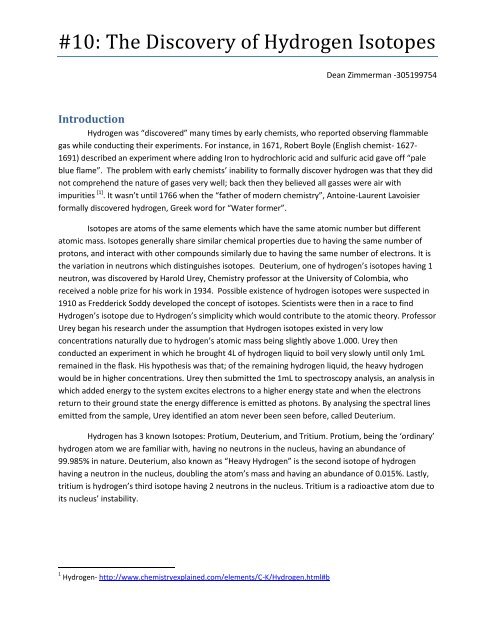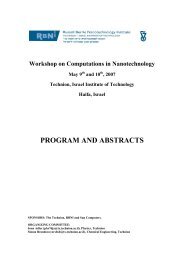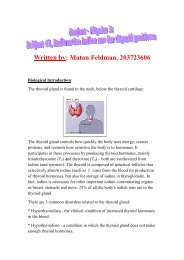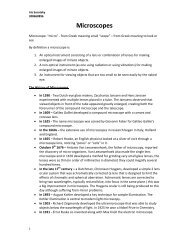#10: The Discovery of Hydrogen Isotopes
#10: The Discovery of Hydrogen Isotopes
#10: The Discovery of Hydrogen Isotopes
Create successful ePaper yourself
Turn your PDF publications into a flip-book with our unique Google optimized e-Paper software.
<strong>#10</strong>: <strong>The</strong> <strong>Discovery</strong> <strong>of</strong> <strong>Hydrogen</strong> <strong>Isotopes</strong><br />
Dean Zimmerman -305199754<br />
Introduction<br />
<strong>Hydrogen</strong> was “discovered” many times by early chemists, who reported observing flammable<br />
gas while conducting their experiments. For instance, in 1671, Robert Boyle (English chemist- 1627-<br />
1691) described an experiment where adding Iron to hydrochloric acid and sulfuric acid gave <strong>of</strong>f “pale<br />
blue flame”. <strong>The</strong> problem with early chemists’ inability to formally discover hydrogen was that they did<br />
not comprehend the nature <strong>of</strong> gases very well; back then they believed all gasses were air with<br />
impurities [1] . It wasn’t until 1766 when the “father <strong>of</strong> modern chemistry”, Antoine-Laurent Lavoisier<br />
formally discovered hydrogen, Greek word for “Water former”.<br />
<strong>Isotopes</strong> are atoms <strong>of</strong> the same elements which have the same atomic number but different<br />
atomic mass. <strong>Isotopes</strong> generally share similar chemical properties due to having the same number <strong>of</strong><br />
protons, and interact with other compounds similarly due to having the same number <strong>of</strong> electrons. It is<br />
the variation in neutrons which distinguishes isotopes. Deuterium, one <strong>of</strong> hydrogen’s isotopes having 1<br />
neutron, was discovered by Harold Urey, Chemistry pr<strong>of</strong>essor at the University <strong>of</strong> Colombia, who<br />
received a noble prize for his work in 1934. Possible existence <strong>of</strong> hydrogen isotopes were suspected in<br />
1910 as Fredderick Soddy developed the concept <strong>of</strong> isotopes. Scientists were then in a race to find<br />
<strong>Hydrogen</strong>’s isotope due to <strong>Hydrogen</strong>’s simplicity which would contribute to the atomic theory. Pr<strong>of</strong>essor<br />
Urey began his research under the assumption that <strong>Hydrogen</strong> isotopes existed in very low<br />
concentrations naturally due to hydrogen’s atomic mass being slightly above 1.000. Urey then<br />
conducted an experiment in which he brought 4L <strong>of</strong> hydrogen liquid to boil very slowly until only 1mL<br />
remained in the flask. His hypothesis was that; <strong>of</strong> the remaining hydrogen liquid, the heavy hydrogen<br />
would be in higher concentrations. Urey then submitted the 1mL to spectroscopy analysis, an analysis in<br />
which added energy to the system excites electrons to a higher energy state and when the electrons<br />
return to their ground state the energy difference is emitted as photons. By analysing the spectral lines<br />
emitted from the sample, Urey identified an atom never been seen before, called Deuterium.<br />
<strong>Hydrogen</strong> has 3 known <strong>Isotopes</strong>: Protium, Deuterium, and Tritium. Protium, being the ‘ordinary’<br />
hydrogen atom we are familiar with, having no neutrons in the nucleus, having an abundance <strong>of</strong><br />
99.985% in nature. Deuterium, also known as “Heavy <strong>Hydrogen</strong>” is the second isotope <strong>of</strong> hydrogen<br />
having a neutron in the nucleus, doubling the atom’s mass and having an abundance <strong>of</strong> 0.015%. Lastly,<br />
tritium is hydrogen’s third isotope having 2 neutrons in the nucleus. Tritium is a radioactive atom due to<br />
its nucleus’ instability.<br />
1 <strong>Hydrogen</strong>- http://www.chemistryexplained.com/elements/C-K/<strong>Hydrogen</strong>.html#b
Figure 1- Three Known <strong>Isotopes</strong> <strong>of</strong> <strong>Hydrogen</strong> [2]<br />
Deuterium and Tritium both have very significant applications in today’s world, which will be discussed<br />
later in this paper.<br />
Deuterium<br />
Deuterium is very similar to 1-<strong>Hydrogen</strong> (Protium) in that it bonds similarly and is stable.<br />
Deuterium, can bond with oxygen to form “heavy water”, which is similar to water only 10% heavier. An<br />
Interesting property <strong>of</strong> heavy water is that heavy ice (heavy water solid) is denser than water, sinking,<br />
depicted in Figure 2. Although Deuterium is very similar to Protium, they do have some distinct physical<br />
properties which are due to the relative large difference in mass. For instance, deuterium has a boiling<br />
point 3 degrees higher than Protium and reacts slower.<br />
Figure 2-Glass <strong>of</strong> water with floating ice and sinking heavy ice (D 2 O) [3]<br />
Extraction<br />
Canada is the world’s supplier <strong>of</strong> heavy water. Heavy water isn’t manufactured but rather<br />
extracted from natural quantity found in lakes (0.015% <strong>of</strong> H). Previous extraction methods suggested<br />
performing electrolysis, running an electric current to drive a non-spontaneous reaction. <strong>The</strong> electrolysis<br />
2 <strong>Hydrogen</strong> Isotope Picture- http://education.jlab.org/glossary/isotope.html<br />
3 http://www.popsci.com/diy/article/2006-07/ice-capades
decomposed the water to Oxygen and <strong>Hydrogen</strong> gas, and due to deuterium larger mass and higher<br />
boiling temperature, the heavy hydrogen is found at the remaining one-millionth volume [4] . This<br />
method works, however it isn’t cost efficient and therefore isn’t promising on a large scale extraction.<br />
<strong>The</strong> plant in Canada directly separates heavy water from water by the use <strong>of</strong> hydrogen sulphide as an<br />
agent [5] , see Figure 3.<br />
Figure 3- Heavy Water Extraction Plant in Canada<br />
Application<br />
Deuterium has many useful applications and due to its unlimited availability (from lakes and<br />
oceans) and cheap extraction methods, looks promising. One application noteworthy is the<br />
strengthening <strong>of</strong> silicon microchips by Deuterium, discovered by Joe Lyding and Karl Hess at the<br />
Beckman Institute’s for Advanced Science and Technology, University <strong>of</strong> Illinois. Prior to their discovery,<br />
the silicon microchips were treated with hydrogen gas during the annealing process (a form <strong>of</strong> heat<br />
treatment used on metals in order to s<strong>of</strong>ten it, relieving internal stresses thereby making it easier to<br />
machine [6] ). Researchers at the Beckman Institute discovered a simple yet important discovery, instead<br />
<strong>of</strong> treating the chip with hydrogen, deuterium is used which dramatically increases the strength and<br />
prolongs the life <strong>of</strong> the chip. How is the microchip strengthened by the deuterium replacing the<br />
hydrogen First let’s look at the microchip with hydrogen, so far the use <strong>of</strong> hydrogen as a protective<br />
agent has been standardized in technological silicon microchips. <strong>The</strong> problem with the hydrogen is that<br />
energetic electrons passing through the microchip have enough energy to knock the hydrogen atoms<br />
out, thus decreasing the performance and life time, being a concern for future smaller microchips. <strong>The</strong><br />
researchers discovered that by using heavy hydrogen as the protective agent in the microchip will<br />
strengthen it by 10-50 times. <strong>The</strong> deuterium atoms can withstand the energetic electrons thus<br />
improving the microchip’s performance and reliability <strong>of</strong> the microchips [7] .<br />
4 Deuterium Extraction by Electrolysis- http://www.britannica.com/nobelprize/article-9435309<br />
5 Heavy Water- http://www.sno.phy.queensu.ca/sno/D2O.html<br />
6 Oxford Dictionary <strong>of</strong> Physics<br />
7 Deuterium in Silicon microchips, clip- http://www.youtube.com/watchv=w9dHeUzwOfI&feature=related
Another important application <strong>of</strong> deuterium is its use in nuclear power reactors. Heavy water is<br />
formed from deuterium, and is used as a moderator and heat transfer agent. Its function as a<br />
moderator is crucial in slowing down the emitted neutrons from nuclear reactions which increases the<br />
fission reaction rate (nuclear reaction in which a large nucleus splits into smaller nuclei thereby emitting<br />
large amounts <strong>of</strong> energy and neutrons). <strong>The</strong> use <strong>of</strong> heavy water in CANDU (Canada’s nuclear power<br />
reactors) enables it to use non-enriched natural uranium, being very cost efficient.<br />
An additional significant application <strong>of</strong> heavy hydrogen is nuclear fusion. Nuclear fusion reaction<br />
is a reaction in which smaller nucleolus atoms collide and fuse together, overcoming repulsive forces,<br />
thereby forming larger atoms and releasing large amounts <strong>of</strong> energy [8] (Example: <strong>Hydrogen</strong> bomb).<br />
Fusion reaction yield enormous amounts <strong>of</strong> energy, being able to harness this energy efficiently while<br />
controlling the reaction (avoiding a massive explosion) will be the ultimate energy source. Deuterium<br />
can be used as the fuel for controlled fusion reaction, this will replace gasoline. One gallon <strong>of</strong> Gasoline<br />
(3.785L) outputs 10 8 Joules <strong>of</strong> Energy, enough to boil 300L <strong>of</strong> water from room temperature, costs<br />
$3.4 [9] (Price in U.S as <strong>of</strong> 19/1/2012). Whereas deuterium used as a fuel in fusion reaction, from 1 gallon<br />
<strong>of</strong> water 0.12g can be extracted at a price <strong>of</strong> $0.04 [10] , which would release 10 10 Joules, enough to boil<br />
30,000L <strong>of</strong> water at a fraction <strong>of</strong> the price <strong>of</strong> gasoline. See Chart 1 for summarized comparison<br />
Fuel Method Resources<br />
Cost ($/Gal)<br />
Energy<br />
Output<br />
(J/Gal)<br />
$3.4 buys<br />
you, energy<br />
(J)<br />
Efficiency<br />
Factor<br />
Gasoline Combustion 3.4 10 8 10 8 1<br />
Deuterium Fusion 0.04 10 10 * 85*10 10 8500<br />
*10 10 Joules/gallon <strong>of</strong> water (0.12g <strong>of</strong> D)<br />
Aside from direct dollar costs, the gasoline availability is limited whereas deuterium in comparison is<br />
unlimited (70% <strong>of</strong> the earth is water). Furthermore, this energy source will trim down dependence on<br />
corrupt middle-eastern countries, saving the world lots <strong>of</strong> troubles. Using nuclear fusion as an energy<br />
source definitely seems promising, however isn’t realistic at the moment as many difficulties must be<br />
resolved.<br />
Tritium<br />
As mentioned, Tritium is an isotope <strong>of</strong> hydrogen having two neutrons in its nucleus. Tritium is<br />
radioactive, having a half life <strong>of</strong> 12.3 years [11] . Tritium, being radioactive, means the nucleus can breakapart<br />
(decay) actively releasing radiation, which can damaged cells, damage DNA and cause Cancer. Due<br />
to tritium’s instability its abundance is 10 -16 % [12] in nature, and therefore has to be artificially produced.<br />
8 Oxford Dictionary <strong>of</strong> Physics<br />
9 Gasoline Price- http://www.eia.gov/petroleum/gasdiesel/<br />
10 Physics for Scientists and Engineers- Serway, 6 th edition pg. 1488<br />
11 General Chemistry- Principles and Modern Applications, 9 th edition- pg 1060<br />
12 Tritium-http://wwsw.ead.anl.gov/pub/doc/tritium.pdf
Production<br />
Tritium occurs naturally in the environment in extremely low quantities to be practically<br />
recovered and so has to be artificially produced. <strong>The</strong>re are several production methods <strong>of</strong> tritium, the<br />
most common and efficient large scale production method is the one used in Savannah River Site (SRS)<br />
in South Carolina. At SRS neutrons are fired at a target consisting <strong>of</strong> lithium, neutrons react with the<br />
lithium and produce tritium along with other by-products.<br />
Application<br />
<strong>The</strong> main application and purpose <strong>of</strong> production <strong>of</strong> tritium is for nuclear weapon, specifically the<br />
hydrogen bomb and nuclear bomb. Tritium gas is used in nuclear weapons’ warhead in order to enhance<br />
its explosive yield [13] . Furthermore, tritium is also used in emergency glow in the dark signs providing<br />
illumination independent <strong>of</strong> electrical supply [14] .<br />
Another remarkable application <strong>of</strong> tritium is its use as a tracer in both research and industry. A tracer is<br />
a radioactive isotope whose presence in a system can be easily detected and monitored. For instance,<br />
suppose a biologist wants to determine the flow <strong>of</strong> water through soil in a specific ecosystem, the<br />
biologist will create water with tritium isotopes (T 2 O) and will be able to monitor the flow <strong>of</strong> the<br />
radioactive water through the soil by using detectors which sense the radiation given <strong>of</strong>f by the<br />
tritium [15] .<br />
Figure 4- <strong>Hydrogen</strong> Bomb<br />
<strong>The</strong> discovery <strong>of</strong> <strong>Hydrogen</strong> <strong>Isotopes</strong> most definitely deserves a noble prize due to its significant influence<br />
on our world today.<br />
13 Tritium Production-http://www.fas.org/spp/starwars/crs/97-002.htm<br />
14 Tritium Production-http://www.globalsecurity.org/wmd/intro/tritium.htm<br />
15 Application <strong>of</strong> Tritium-http://www.chemistryexplained.com/elements/C-K/<strong>Hydrogen</strong>.html#b








